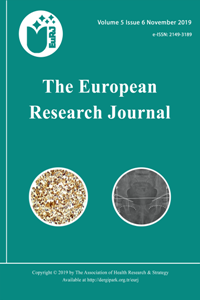Abstract
References
- [1] Asadi-Samani M, Moradi MT, Mahmoodnia L, Alaei S, Asadi-Samani F, Luther T. Traditional uses of medicinal plants to prevent and treat diabetes; an updated review of ethnobotanical studies in Iran. J Nephropathol 2017;6:118-25.
- [2] Rechinger KH. Flora Iranica: no. 150. Labiatae. Graz, Akademische Druck- und Verlagsanstalt, 1982.
- [3] Raei F, Ashoori N, Eftekhar F, Yousefzadi M. Chemical composition and antibacterial activity of Teucrium polium essential oil against urinary isolates of Klebsiella pneumonia. J Essent Oil Res 2014;26:65-9.
- [4] Ali Asgar MD. Anti-diabetic potential of phenolic compounds: a review. Int J Food Prop 2013;16:91-103.
- [5] Baradaran A, Madihi Y, Merrikhi A, Rafieian Kopaei M, Nematbakhsh M, Asgari A, et al. Nephrotoxicity of hydroalcoholic extract of Teucrium polium in Wistar rats. Pak J Med Sci 2013;29:329-33.
Abstract
Herbal medicines are believed
to be effective in the treatment of many diseases. The genius Teucrium is
a member of Lamiaceae family, which contains more than 300 species. Antimutagenic,
anticancer, hypoglycemic, antibacterial, anti-inflammatory, antipyretic, antiulcer,
hypolipidemic and antidiarrheal effects of Teucrium polium have been reported
in the studies. In this article, we describe an acute kidney injury (AKI), which is thought to have developed as a result of T.
polium use for the treatment of diabetes mellitus.
It should not be forgotten that herbal medicine is an important reason for AKI.
In addition, community should be made aware of the danger of herbal medicines which
especially have potential renal and hepatic side effects.
References
- [1] Asadi-Samani M, Moradi MT, Mahmoodnia L, Alaei S, Asadi-Samani F, Luther T. Traditional uses of medicinal plants to prevent and treat diabetes; an updated review of ethnobotanical studies in Iran. J Nephropathol 2017;6:118-25.
- [2] Rechinger KH. Flora Iranica: no. 150. Labiatae. Graz, Akademische Druck- und Verlagsanstalt, 1982.
- [3] Raei F, Ashoori N, Eftekhar F, Yousefzadi M. Chemical composition and antibacterial activity of Teucrium polium essential oil against urinary isolates of Klebsiella pneumonia. J Essent Oil Res 2014;26:65-9.
- [4] Ali Asgar MD. Anti-diabetic potential of phenolic compounds: a review. Int J Food Prop 2013;16:91-103.
- [5] Baradaran A, Madihi Y, Merrikhi A, Rafieian Kopaei M, Nematbakhsh M, Asgari A, et al. Nephrotoxicity of hydroalcoholic extract of Teucrium polium in Wistar rats. Pak J Med Sci 2013;29:329-33.
Details
| Primary Language | English |
|---|---|
| Subjects | Internal Diseases, Neurology and Neuromuscular Diseases |
| Journal Section | Case Reports |
| Authors | |
| Publication Date | November 4, 2019 |
| Submission Date | September 20, 2018 |
| Acceptance Date | March 22, 2019 |
| Published in Issue | Year 2019 Volume: 5 Issue: 6 |
Cited By
Teucrium polium: new toxic effects added to the literature: a case report
Annals of Medicine & Surgery
https://doi.org/10.1097/MS9.0000000000001760
Teucrium polium - wound healing potential, toxicity and polyphenolic profile
South African Journal of Botany
https://doi.org/10.1016/j.sajb.2020.10.017



